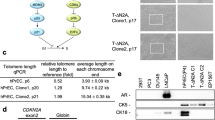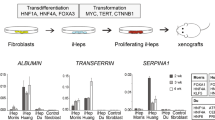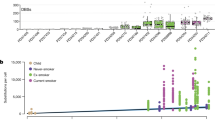Abstract
CELLS derived from several animal species, including mouse1,2, hamster3 and rat4, have been transformed in vitro from the normal to the malignant state by diverse chemical carcinogens. In similar conditions, however, attempts to transform human cells have usually been unsuccessful and as far as we know, such transformation has been reported only once5. This was a case of two cell lines treated with urethane, obtained from siblings with von Recklinghausen's disease, a familial disorder transmitted by an autosomal dominant gene, and characterised by multiple fibromas with a high predisposition to malignant transformation in vivo6. Although morphologically altered foci of transformed cells were reported, there was the possibility that a few tumour cells in the original population had been selected for by urethane. Therefore we characterised in detail the urethane-treated and untreated cultures. We have found that human cells can indeed be chemically transformed in vitro.
This is a preview of subscription content, access via your institution
Access options
Subscribe to this journal
Receive 51 print issues and online access
$199.00 per year
only $3.90 per issue
Buy this article
- Purchase on Springer Link
- Instant access to full article PDF
Prices may be subject to local taxes which are calculated during checkout
Similar content being viewed by others
References
Chen, T. T., and Heidelberger, C., Int. J. Cancer, 4, 166–178 (1969).
Reznikoff, C. A., Brankow, D. W., and Heidelberger, C., Cancer Res., 33, 3231–3238 (1973).
Berward, Y., and Sachs, L., J. natn. Cancer Inst., 35, 641–661 (1965).
Freeman, A. E., Gilden, R. V., Vernon, M. L., Wolford, R. G., Hugunin, P., and Huebner, R. J., Proc. natn. Acad. Sci. U.S.A., 70, 2415–2419 (1973).
Igel, H. J., Freeman, A. E., Spiewak, J. E., and Kleinfeld, K. L., In Vitro (in the press).
Crowe, F. W., Schull, W. J., and Neel, J. V., A Clinical Pathology and Genetic Study of Multiple Neurofibromatosis (C. C. Thomas, Springfield, 1956).
Paul, B., Porter, I. H., and Benedict, W. F., Humangenetik, 18, 185–187 (1973).
Laug, W. E., Jones, P. A., and Benedict, W. F., J. natn. Cancer Inst., 54, 173–179 (1975).
Atkin, N. B., and Baker, M. C., J. natn. Cancer Inst., 36, 539–557 (1966).
Porter, I. H., Benedict, W. F., Brown, C. D., and Paul, B., Expl molec. Path., 11, 340–367 (1970).
Freeman, A. E., and Price, P. J., in Proc. Conf. Carcinogenesis Testing of New Drugs (edit. by Goldberg, L.), 23–25 (Chemical Rubber Company, 1974).
McAllister, R. M., et al., Cancer (in the press).
Author information
Authors and Affiliations
Rights and permissions
About this article
Cite this article
BENEDICT, W., JONES, P., LAUG, W. et al. Characterisation of human cells transformed in vitro by urethane. Nature 256, 322–324 (1975). https://doi.org/10.1038/256322a0
Received:
Accepted:
Issue Date:
DOI: https://doi.org/10.1038/256322a0
This article is cited by
Comments
By submitting a comment you agree to abide by our Terms and Community Guidelines. If you find something abusive or that does not comply with our terms or guidelines please flag it as inappropriate.



